|
| |
Family ACRIDIDAE
- This page contains pictures and information about Moisture-loving Grasshoppers
in subfamily Oxyinae that we found in the
Brisbane area, Queensland, Australia.
-
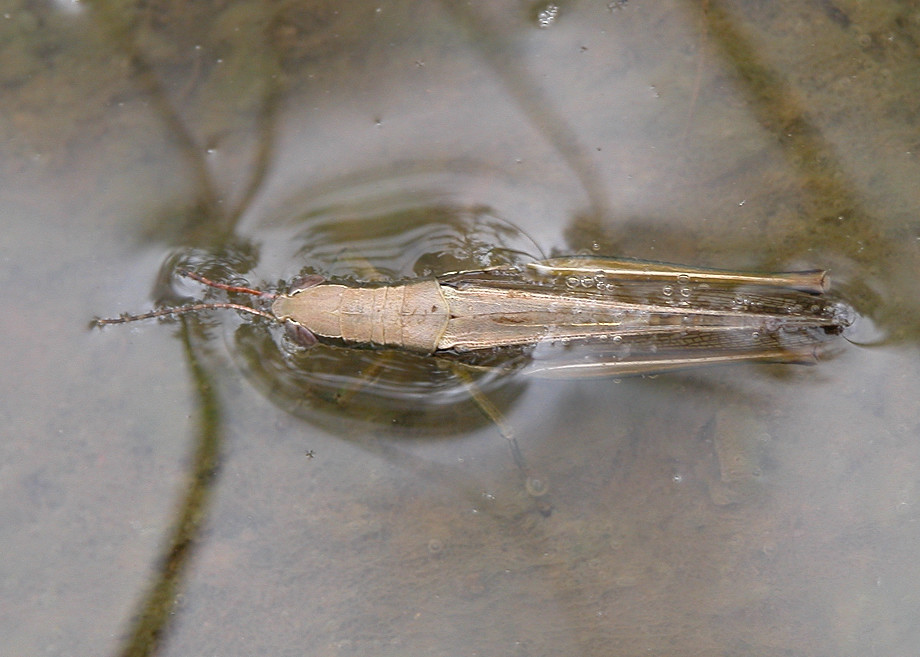 -
- Grasshoppers in this subfamily Oxyinae usually associated with water and
grasslands. Some Oxyine grasshoppers even submerge themselves under water
surface to avoid predators. They have a number of adaptations for their semiaquatic life
style, including the smooth
body surface.
-
- The Grasshoppers feed on blade grasses and sedges that grow near the water edge. They
swim near the surface when jump into the water. They
are different from other grasshoppers with
their shiny and smooth surface. This feature could be an advantage when
swimming in water.
-
- Grasshoppers
in Oxyinae are usually grass-green in colours with black and white longitudinal
bands. Most
of them are fast fliers and good jumpers.
-
Tribe Oxyini
- Grasshoppers in this tribe are from medium to large in size. Most species
adults, both males and females, are fully winged. Most of them live just next
to flash water among tall grasses. They feed on leaves of grasses and sedges.
-
- Diving Grasshopper
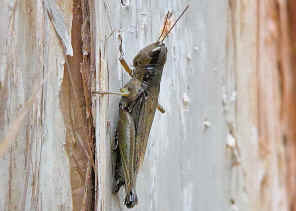
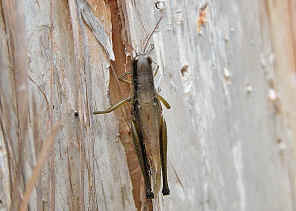 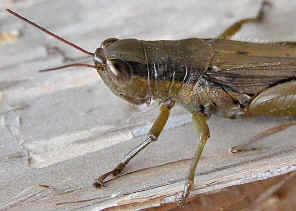 - Bermiella
acuta, body length 40mm
- This is a large grasshopper. From reference information, this grasshopper
can remain underwater for more than ten minutes. The grasshopper can be recognized by the hind femora with the
dorsal angles spiniform and antenna are not banded. Please check this page
for more information.
-
-
- Creek Grasshopper, Eastern Toothed
Bermius
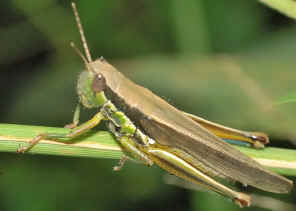
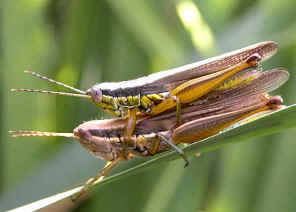 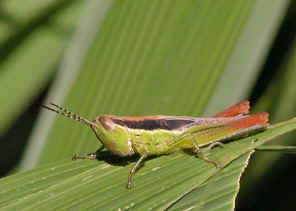 - Bermius odontocercus, body length male 35, female 40mm
nymph
- We easily found this Creek Grasshoppers along Bulimba Creek in Yugarapul
Park in Brisbane. They usually hide among tall grasses or reeds next
to the water edge. The nymph and adult look the same except adult has fully
winged. The grasshoppers are grass-green in colour with black strips on
both sides along body from eyes to wing tips. The top of the head and
thorax is brown in colour. More pictures and information can be found in this page.
-
-
- Garden Bermius
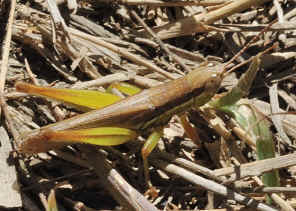
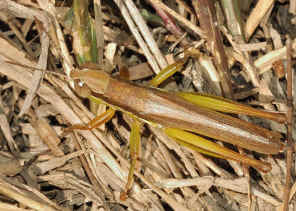
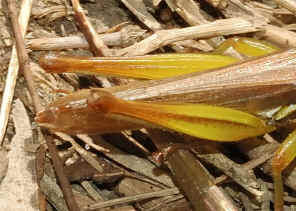 - Bermius brachycerus, body length 25mm
- We
found this Garden Bermius Grasshopper on Apr 2007 in Karawatha Forest near the Lagoon. This
species is less common than the above species Creek
Grasshopper in Brisbane. Please check this page
for more information.
-
-
- Common Gesonula
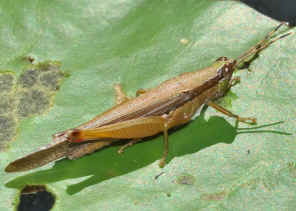 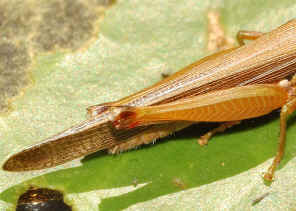
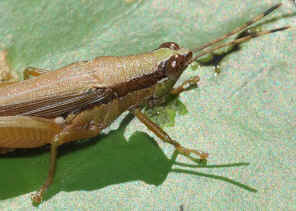 - Gesonula mundata, body length 30mm
- This
is a northern Australian species and not suppose to found them here in
Brisbane. We found one once in Karawatha Forest on July 2007. It was on Hakea
Track at the edge of a small pond. Please check this page
for more information.
-
-
- Rice Grasshopper
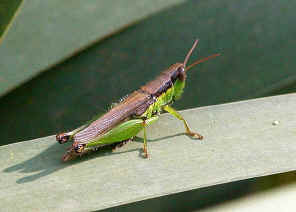
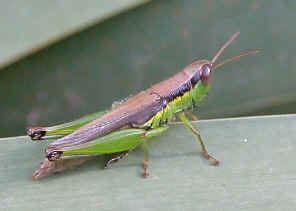
- Oxya japonica, body length 30mm
- This species is common in south-east Asia, but not common in Brisbane. We
found it only once in Brisbane on Dec 2004. Please check this page
for more information.
-
Tribe Praxibulini
- Those species we found in this tribe, the adults are reduced-wings. They
are small to medium in size. They are mostly bright-green or brown with
black in colours.
-
- Beautiful Methiola
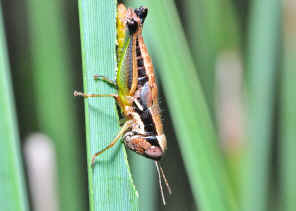
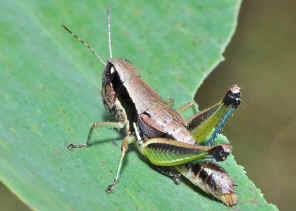
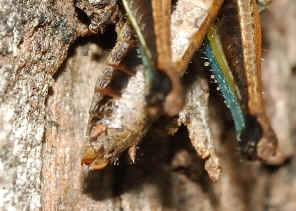 - Methiola sp.4 , body length 20mm
- Beautiful Methiola is a medium size grasshopper. Both adult males and
females are flightless with reduced-wings. The body is grey-brown in colour
with black strips. However, the hind legs are beautiful with multiple
colours, from pale brown to green to blue then black. The keen s are black
in colour. We have more information and pictures in this page.
-
-
- Green Methiola
-
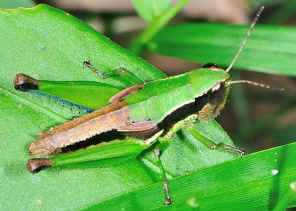
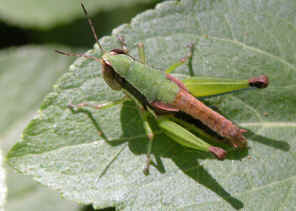 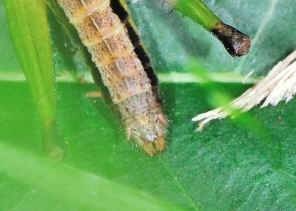
- Methiola sp., body length 20mm
- This Green Methiola looked very similar to the above species except in
different body colour scheme. Their abdomen is about the same, with black
strip on pale brown. The Green Methiola has the green head and green thorax.
All legs are green colour as well. The keens are the same black colour. Both
species can be found in the same area at the same time. Please check this page
for more information.
-
-
- Little Black-knees

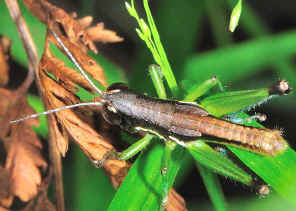
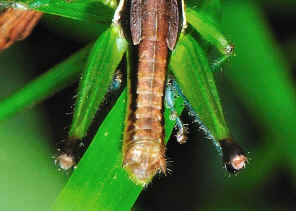 - Methiolopsis geniculata, body length 15mm
- This little grasshopper is black in colour with white strip on each side.
All its legs are bright green with black knees. Please check this page
for more information.
- Reference:
- 1. Grasshopper
Country - the Abundant Orthopteroid Insects of Australia, D Rentz,
UNSW Press, 1996, p179.
- 2. A Guide to Australian Grasshoppers and Locusts - DCF
Rentz, RC Lewis, YN Su and MS Upton, 2003, p78.
- 3. Northern
Territory Insects, A Comprehensive Guide CD - Graham Brown, 2009.
Back to top
[ Up ] [ Oxyinae ] [ Catantopinae ] [ Acridinae ] | |
|
























